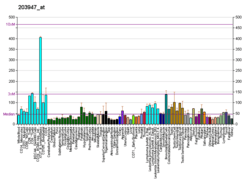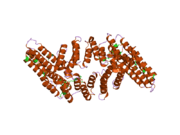CSTF3
Cleavage stimulation factor 77 kDa subunit is a protein that in humans is encoded by the CSTF3 gene.[5][6]
The protein encoded by this gene is one of three (including CSTF1 and CSTF2) cleavage stimulation factors that combine to form the cleavage stimulation factor complex (CSTF). This complex is involved in the polyadenylation and 3' end cleavage of pre-mRNAs. The encoded protein functions as a homodimer and interacts directly with both CSTF1 and CSTF2 in the CSTF complex. Alternative splicing results in multiple transcript variants encoding different isoforms.[6]
Interactions
CSTF3 has been shown to interact with CSTF2.[7]
gollark: How do I use this?
gollark: It's been discussed for ages.
gollark: It *works*?!
gollark: [ω² apioexclamatohazards]
gollark: '11!¹!!one!¡¡!one1¹¹one1one¡¡one1one¹1!1¹¡oneone¡1one!¡one!¡one¡¡11¡¹¡¡one!one1!¡¡1one¹oneone1oneone¡¡¹one¹¡one¹¡11¹!1!11¹!one11one1one!¹!1!¹oneone¡1¹¹
References
- GRCh38: Ensembl release 89: ENSG00000176102 - Ensembl, May 2017
- GRCm38: Ensembl release 89: ENSMUSG00000027176 - Ensembl, May 2017
- "Human PubMed Reference:". National Center for Biotechnology Information, U.S. National Library of Medicine.
- "Mouse PubMed Reference:". National Center for Biotechnology Information, U.S. National Library of Medicine.
- Takagaki Y, Manley JL (December 1994). "A polyadenylation factor subunit is the human homologue of the Drosophila suppressor of forked protein". Nature. 372 (6505): 471–4. Bibcode:1994Natur.372..471T. doi:10.1038/372471a0. PMID 7984242.
- "Entrez Gene: CSTF3 cleavage stimulation factor, 3' pre-RNA, subunit 3, 77kDa".
- Takagaki, Y; Manley J L (March 2000). "Complex protein interactions within the human polyadenylation machinery identify a novel component". Mol. Cell. Biol. 20 (5): 1515–25. doi:10.1128/MCB.20.5.1515-1525.2000. ISSN 0270-7306. PMC 85326. PMID 10669729.
External links
- Human CSTF3 genome location and CSTF3 gene details page in the UCSC Genome Browser.
Further reading
- Takagaki Y, Manley JL (1992). "A human polyadenylation factor is a G protein beta-subunit homologue". J. Biol. Chem. 267 (33): 23471–4. PMID 1358884.
- Takagaki Y, MacDonald CC, Shenk T, Manley JL (1992). "The human 64-kDa polyadenylylation factor contains a ribonucleoprotein-type RNA binding domain and unusual auxiliary motifs". Proc. Natl. Acad. Sci. U.S.A. 89 (4): 1403–7. Bibcode:1992PNAS...89.1403T. doi:10.1073/pnas.89.4.1403. PMC 48459. PMID 1741396.
- Murthy KG, Manley JL (1995). "The 160-kD subunit of human cleavage-polyadenylation specificity factor coordinates pre-mRNA 3'-end formation". Genes Dev. 9 (21): 2672–83. doi:10.1101/gad.9.21.2672. PMID 7590244.
- Takagaki Y, Manley JL (2000). "Complex protein interactions within the human polyadenylation machinery identify a novel component". Mol. Cell. Biol. 20 (5): 1515–25. doi:10.1128/MCB.20.5.1515-1525.2000. PMC 85326. PMID 10669729.
- Emili A, Schieltz DM, Yates JR, Hartwell LH (2001). "Dynamic interaction of DNA damage checkpoint protein Rad53 with chromatin assembly factor Asf1". Mol. Cell. 7 (1): 13–20. doi:10.1016/S1097-2765(01)00150-2. PMID 11172707.
- Benoit B, Juge F, Iral F, et al. (2002). "Chimeric human CstF-77/Drosophila Suppressor of forked proteins rescue suppressor of forked mutant lethality and mRNA 3' end processing in Drosophila". Proc. Natl. Acad. Sci. U.S.A. 99 (16): 10593–8. Bibcode:2002PNAS...9910593B. doi:10.1073/pnas.162191899. PMC 124984. PMID 12149458.
- Strausberg RL, Feingold EA, Grouse LH, et al. (2003). "Generation and initial analysis of more than 15,000 full-length human and mouse cDNA sequences". Proc. Natl. Acad. Sci. U.S.A. 99 (26): 16899–903. Bibcode:2002PNAS...9916899M. doi:10.1073/pnas.242603899. PMC 139241. PMID 12477932.
- Kaufmann I, Martin G, Friedlein A, et al. (2005). "Human Fip1 is a subunit of CPSF that binds to U-rich RNA elements and stimulates poly(A) polymerase". EMBO J. 23 (3): 616–26. doi:10.1038/sj.emboj.7600070. PMC 1271804. PMID 14749727.
- Gerhard DS, Wagner L, Feingold EA, et al. (2004). "The status, quality, and expansion of the NIH full-length cDNA project: the Mammalian Gene Collection (MGC)". Genome Res. 14 (10B): 2121–7. doi:10.1101/gr.2596504. PMC 528928. PMID 15489334.
- Kim J, Bhinge AA, Morgan XC, Iyer VR (2005). "Mapping DNA-protein interactions in large genomes by sequence tag analysis of genomic enrichment". Nat. Methods. 2 (1): 47–53. doi:10.1038/nmeth726. PMID 15782160.
- Rual JF, Venkatesan K, Hao T, et al. (2005). "Towards a proteome-scale map of the human protein-protein interaction network". Nature. 437 (7062): 1173–8. Bibcode:2005Natur.437.1173R. doi:10.1038/nature04209. PMID 16189514.
- Taylor TD, Noguchi H, Totoki Y, et al. (2006). "Human chromosome 11 DNA sequence and analysis including novel gene identification". Nature. 440 (7083): 497–500. Bibcode:2006Natur.440..497T. doi:10.1038/nature04632. PMID 16554811.
- Olsen JV, Blagoev B, Gnad F, et al. (2006). "Global, in vivo, and site-specific phosphorylation dynamics in signaling networks". Cell. 127 (3): 635–48. doi:10.1016/j.cell.2006.09.026. PMID 17081983.
- Ewing RM, Chu P, Elisma F, et al. (2007). "Large-scale mapping of human protein-protein interactions by mass spectrometry". Mol. Syst. Biol. 3 (1): 89. doi:10.1038/msb4100134. PMC 1847948. PMID 17353931.
This article is issued from Wikipedia. The text is licensed under Creative Commons - Attribution - Sharealike. Additional terms may apply for the media files.







